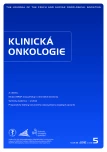BRAF Mutation: a Novel Approach in Targeted Melanoma Therapy
Authors:
M. Arenbergerová 1; I. Puzanov 2
Authors‘ workplace:
Dermatovenerologická klinika 3. LF UK a FNKV, Praha
1; Vanderbilt-Ingram Cancer Center, Nashville, USA
2
Published in:
Klin Onkol 2012; 25(5): 323-328
Category:
Reviews
Overview
The incidence of malignant melanoma is increasing worldwide, despite our best efforts in prevention and early detection. The locally advanced disease may be treated surgically with good results, however, metastatic melanoma is considered to be one of the most therapeutically challenging malignancies. The increasing knowledge of molecular changes in melanoma may change this picture. Malignant melanoma is not a singular, homogeneous disease but rather a mixture of subtypes characterized by specific mutations. Tumors with C-KIT mutation respond to therapy with C-KIT kinase inhibitor imatinib and the ones characterized by BRAF mutations respond to BRAF kinase inhibitor vemurafenib. Vemurafenib was approved by US FDA in 2011 and EMA in 2012 for therapy of patients with advanced melanoma, harboring mutation in BRAFV600E gene. Ipilimumab, an antibody to cytotoxic T-lymphocyte antigen 4 (CTLA-4), was registered in 2011 by both US FDA and European Medicines Agency for treatment of metastatic melanoma. This therapy promotes the anti-tumor T-cell activity by blocking a CTLA-4 antigen, a key negative regulator of immune response.
Key words:
melanoma – targeted therapy – BRAF kinase – vemurafenib – immunotherapy – neoplasm metastasis
Submitted:
2. 3. 2012
Accepted:
11. 4. 2012
Sources
1. Atkins MB, Lotze MT, Dutcher JP et al. High-dose recombinant interleukin 2 therapy for patients with metastatic melanoma: analysis of 270 patients treated between 1985 and 1993. J Clin Oncol 1999; 17(7): 2105–2116.
2. Smith FO, Downey SG, Klapper JA et al. Treatment of metastatic melanoma using interleukin-2 alone or in conjunction with vaccines. Clin Cancer Res 2008; 14(17): 5610–5618.
3. Hodi FS, O’Day SJ, McDermott DF et al. Improved survival with ipilimumab in patients with metastatic melanoma. N Engl J Med 2010; 363(8): 711–723.
4. Greenman C, Stephens P, Smith R et al. Patterns of somatic mutation in human cancer genomes. Nature 2007; 446(7132): 153–158.
5. Davies H, Bignell GR, Cox C et al. Mutations of the BRAF gene in human cancer. Nature 2002; 417(6892): 949–954.
6. Curtin JA, Busam K, Pinkel D et al. Somatic activation of KIT in distinct subtypes of melanoma. J Clin Oncol 2006; 24(26): 4340–4346.
7. Maldonado JL, Fridlyand J, Patel H et al. Determinants of BRAF mutations in primary melanomas. J Natl Cancer Inst 2003; 95(24): 1878–1890.
8. Hauschild A, Agarwala SS, Trefzer U et al. Results of a phase III, randomized, placebo-controlled study of sorafenib in combination with carboplatin and paclitaxel as second-line treatment in patients with unresectable stage III or stage IV melanoma. J Clin Oncol 2009; 27(17): 2823–2830.
9. Flaherty KT, Puzanov I, Kim KB et al. Inhibition of mutated, activated BRAF in metastatic melanoma. N Engl J Med 2010; 363(9): 809–819.
10. Sosman JA, Kim KB, Schuchter L et al. Survival in BRAF V600-mutant advanced melanoma treated with vemurafenib (BRIM2). N Engl J Med 2012; 366(8): 707–714.
11. Oberholzer P, Kee D, Dziunycz P et al. RAS mutations are associated with the development of cutaneous squamous cell tumors in patients treated with RAF inhibitors. J Clin Oncol 2012; 30(3): 316–321.
12. Su F, Viros A, Milagre C et al. RAS mutations in cutaneous squamous-cell carcinomas in patients treated with BRAF inhibitors. N Engl J Med 2012; 366(3): 207–215.
13. Ema.europa.eu [online]. European Medicine Agency. Zelboraf – Souhrn údajů o přípravku [aktualizováno 19. března 2012; citováno 19. března 2012]. Dostupný z: http://www.ema.europa.eu/docs/cs_CZ/document_library/EPAR_Product_Information/human/002409/WC500124317.pdf.
14. Chapman PB, Hauschild A, Robert C et al. Improved survival with vemurafenib in melanoma with BRAF V600E mutation. N Engl J Med 2011; 364(26): 2507–2516.
15. Kobayashi S, Boggon TJ, Dayaram T et al. EGFR mutation and resistance of non-small-cell lung cancer to gefitinib. N Engl J Med 2005; 352(8): 786–792.
16. Montagut C, Sharma SV, Shioda T et al. Elevated CRAF as a potential mechanism of acquired resistance to BRAF inhibition in melanoma. Cancer Res 2008; 68(12): 4853–4861.
17. Nazarian R, Shi H, Wang Q et al. Melanomas acquire resistance to B-RAF(V600E) inhibition by RTK or N-RAS upregulation. Nature 2010; 468(7326): 973–977.
18. Johannessen CM, Boehm JS, Kim SY et al. COT drives resistance to RAF inhibition through MAP kinase pathway reactivation. Nature 2010; 468(7326): 968–972.
19. Poulikakos PI, Persaud Y, Janakiraman M et al. RAF inhibitor resistance is mediated by dimerization of aberrantly spliced BRAF(V600E). Nature 2011; 480(7377): 387–390.
20. Prahallad A, Sun C, Huang S et al. Unresponsiveness of colon cancer to BRAF(V600E) inhibition through feedback activation of EGFR. Nature 2012; 483(7387): 100–103.
21. Wymann MP, Marone R. Phosphoinositide 3-kinase in disease: timing, location, and scaffolding. Curr Opin Cell Biol 2005; 17(2): 141–149.
22. Heneberg P. Advances in clinical treatment of malignant melanoma: B-RAF kinase inhibition. Klin Onkol 2011; 24(4): 256–264.
23. Ribas A, Kim KB, Schuchter LM et al. BRIM-2: an open label multicenter phase 2 study of vemurafenib in previously treated patients with BRAF V600E mutation-positive metastatic melanoma. Abstract 8509. J Clin Oncol 2011; 29: 15S.
Labels
Paediatric clinical oncology Surgery Clinical oncologyArticle was published in
Clinical Oncology

2012 Issue 5
- Metamizole vs. Tramadol in Postoperative Analgesia
- Metamizole at a Glance and in Practice – Effective Non-Opioid Analgesic for All Ages
- The Importance of Hydration in Wound Healing
- Obstacle Called Vasospasm: Which Solution Is Most Effective in Microsurgery and How to Pharmacologically Assist It?
- Possibilities of Using Metamizole in the Treatment of Acute Primary Headaches
Most read in this issue
- Uterine Sarcomas – a Review
- Analysis of Prognostic Factors in Osteosarcoma Adult Patients, a Single Institution Experience
- Bloodstream Infections of the Intravascular Access Devices – Case Reports and Review of the Literature
- BRAF Mutation: a Novel Approach in Targeted Melanoma Therapy
